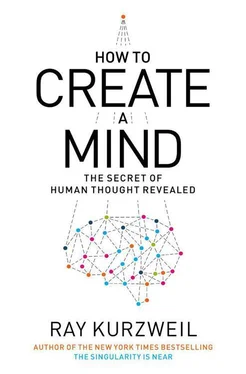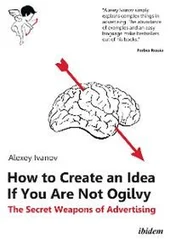In another split-brain experiment the researchers showed the word “bell” to the right brain and “music” to the left brain. The patient was asked what word he saw. The left-hemisphere-controlled speech center says “music.” The subject was then shown a group of pictures and asked to point to a picture most closely related to the word he was just shown. His right-hemisphere-controlled arm pointed to the bell. When he was asked why he pointed to the bell, his left-hemisphere-controlled speech center replied, “Well, music, the last time I heard any music was the bells banging outside here.” He provided this explanation even though there were other pictures to choose from that were much more closely related to music.
Again, this is a confabulation. The left hemisphere is explaining as if it were its own a decision that it never made and never carried out. It is not doing so to cover up for a friend (that is, its other hemisphere)—it genuinely thinks that the decision was its own.
These reactions and decisions can extend to emotional responses. They asked a teenage split-brain patient—so that both hemispheres heard—“Who is your favorite…” and then fed the word “girlfriend” just to the right hemisphere through the left ear. Gazzaniga reports that the subject blushed and acted embarrassed, an appropriate reaction for a teenager when asked about his girlfriend. But the left-hemisphere-controlled speech center reported that it had not heard any word and asked for clarification: “My favorite what?” When asked again to answer the question, this time in writing, the right-hemisphere-controlled left hand wrote out his girlfriend’s name.
Gazzaniga’s tests are not thought experiments but actual mind experiments. While they offer an interesting perspective on the issue of consciousness, they speak even more directly to the issue of free will. In each of these cases, one of the hemispheres believes that it has made a decision that it in fact never made. To what extent is that true for the decisions we make every day?
Consider the case of a ten-year-old female epileptic patient. Neurosurgeon Itzhak Fried was performing brain surgery while she was awake (which is feasible because there are no pain receptors in the brain). 14 Whenever he stimulated a particular spot on her neocortex, she would laugh. At first the surgical team thought that they might be triggering some sort of laugh reflex, but they quickly realized that they were triggering the actual perception of humor. They had apparently found a point in her neocortex—there is obviously more than one—that recognizes the perception of humor. She was not just laughing—she actually found the situation funny, even though nothing had actually changed in the situation other than their having stimulated this point in her neocortex. When they asked her why she was laughing, she did not reply along the lines of, “Oh, no particular reason,” or “You just stimulated my brain,” but would immediately confabulate a reason. She would point to something in the room and try to explain why it was funny. “You guys are just so funny standing there” was a typical comment.
We are apparently very eager to explain and rationalize our actions, even when we didn’t actually make the decisions that led to them. So just how responsible are we for our decisions? Consider these experiments by physiology professor Benjamin Libet (1916–2007) at the University of California at Davis. Libet had participants sit in front of a timer, EEG electrodes attached to their scalps. He instructed them to do simple tasks such as pushing a button or moving a finger. The participants were asked to note the time on the timer when they “first become aware of the wish or urge to act.” Tests indicated a margin of error of only 50 milliseconds on these assessments by the subjects. They also measured an average of about 200 milliseconds between the time when the subjects reported awareness of the urge to act and the actual act. 15
The researchers also looked at the EEG signals coming from the subjects’ brains. Brain activity involved in initiating the action by the motor cortex (which is responsible for carrying out the action) actually occurred on average about 500 milliseconds prior to the performance of the task. That means that the motor cortex was preparing to carry out the task about a third of a second before the subject was even aware that she had made a decision to do so.
The implications of the Libet experiments have been hotly debated. Libet himself concluded that our awareness of decision making appears to be an illusion, that “consciousness is out of the loop.” Philosopher Daniel Dennett commented, “The action is originally precipitated in some part of the brain, and off fly the signals to muscles, pausing en route to tell you, the conscious agent, what is going on (but like all good officials letting you, the bumbling president, maintain the illusion that you started it all).” 16 At the same time Dennett has questioned the timings recorded by the experiment, basically arguing that subjects may not really be aware of when they become aware of the decision to act. One might wonder: If the subject is unaware of when she is aware of making a decision, then who is? But the point is actually well taken—as I discussed earlier, what we are conscious of is far from clear.
Indian American neuroscientist Vilayanur Subramanian “Rama” Ramachandran (born in 1951) explains the situation a little differently. Given that we have on the order of 30 billion neurons in the neocortex, there is always a lot going on there, and we are consciously aware of very little of it. Decisions, big and little, are constantly being processed by the neocortex, and proposed solutions bubble up to our conscious awareness. Rather than free will, Ramachandran suggests we should talk about “free won’t”—that is, the power to reject solutions proposed by the nonconscious parts of our neocortex.
Consider the analogy to a military campaign. Army officials prepare a recommendation to the president. Prior to receiving the president’s approval, they perform preparatory work that will enable the decision to be carried out. At a particular moment, the proposed decision is presented to the president, who approves it, and the rest of the mission is then undertaken. Since the “brain” represented by this analogy involves the unconscious processes of the neocortex (that is, the officials under the president) as well as its conscious processes (the president), we would see neural activity as well as actual actions taking place prior to the official decision’s being made. We can always get into debates in a particular situation as to how much leeway the officials under the president actually gave him or her to accept or reject a recommendation, and certainly American presidents have done both. But it should not surprise us that mental activity, even in the motor cortex, would start before we were aware that there was a decision to be made.
What the Libet experiments do underscore is that there is a lot of activity in our brains underlying our decisions that is not conscious. We already knew that most of what goes in the neocortex is not conscious; it should not be surprising, therefore, that our actions and decisions stem from both unconscious and conscious activity. Is this distinction important? If our decisions arise from both, should it matter if we sort out the conscious parts from the unconscious? Is it not the case that both aspects represent our brain? Are we not ultimately responsible for everything that goes on in our brains? “Yes, I shot the victim, but I’m not responsible because I wasn’t paying attention” is probably a weak defense. Even though there are some narrow legal grounds on which a person may not be held responsible for his decisions, we are generally held accountable for all of the choices we make.
Читать дальше












